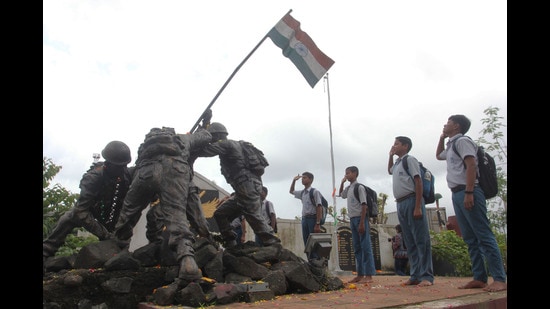The Kargil war of May-July 1999 with Pakistan occupies a unique place in our history. It was truly a mini-war in terms of casualties, intensity of operations, and geographical scope. The 1947 war was fought all over Kashmir, the 1965 war in Rajasthan, Punjab and Kashmir, and the 1971 war was subcontinental.

The length of the Kargil front was just about 200 kilometres, because of the Indian decision to contain the first war fought after the nuclearisation of the subcontinent. Its reality was beamed into India’s living rooms through TV cameras that took up position alongside artillery guns on the road, from where the soldiers went uphill by foot and launched their attacks on entrenched Pakistani positions at considerable cost to themselves.
This required a high degree of dedication and sheer bravery; there was little room to manoeuvre, as a result of which 470 military personnel were killed. Tololing, Tiger Hill, Mashkoh, and Batalik became household names, as did those of brave hearts like Manoj Pandey, Vikram Batra, Yogendra Yadav, and Sanjay Kumar.
The war was a major shock for India. Just months earlier, in February, Prime Minister (PM) Atal Bihari Vajpayee had tried to put India-Pakistan relations on a new trajectory. He had travelled by bus to Lahore to inaugurate a cross-border bus service and made it a point to visit the Minar-e-Pakistan, the monument to Pakistan’s founding.
But this was not to the liking of the Pakistan army, whose covert war against India was on in Kashmir. Why Pakistan launched a military operation in Kargil, though, remains a mystery. It could perhaps be put down only to the incompetence of its strategists.
The operation was aimed to stoke global alarm, over two nuclear-armed adversaries going to war. But it blew up in Pakistan’s face. Almost no one accepted its version of events, especially its ludicrous claim that the Kashmiri mujahideen were running the war from an area where the Line of Control (LoC) was not clear.
Pakistan PM Nawaz Sharif rushed to Beijing for support, but returned empty-handed. Desperate, he landed up in the US on July 4, American Independence Day. President Bill Clinton read him the riot act and asked him to pull back Pakistani forces.
Having established its battlefield dominance through sheer grit, the Indian side allowed the rest of the Pakistani intruders to withdraw following an agreement. India’s clear diplomatic gain was the global acceptance of the sanctity of the LoC in Kashmir.
There is little doubt that there was significant intelligence failure on India’s part. The first was strategic intelligence failure in discerning the divisions within the Pakistan government before Vajpayee’s Lahore visit. The second was the inability to detect the movement of Pakistani forces in the region through optical or electronic means or through routine winter patrols. The Research & Analysis Wing (R&AW), charged with keeping a close track of the Pakistani military, failed to detect the movements of the Northern Light Infantry units used by Pakistan for the incursion.
The Kargil Review Committee Report, From Surprise to Reckoning, summed up the story. Chaired by K Subrahmanyam, the committee noted baldly that “India was not militarily well prepared.” It looked into the operational management by the Army and brought out many lacunae, especially in intelligence. The inputs to R&AW and the Intelligence Bureau (IB) in 1997 and 1998, or those to the northern command, were extensively examined and indicated that something was being planned. But, at the end of the day, the intelligence agencies failed to accurately assess the information. This is similar to what happened in eastern Ladakh in 2020.
Within 14 months, a group of ministers (GOM) set up by the Vajpayee government came up with a set of recommendations for reforming the Indian armed forces. This has been the most ambitious and extensive endeavour of its kind. Unlike commissions headed by officials, the GOM comprised the four members of the Cabinet Committee on Security (CCS) — deputy PM and home minister LK Advani, defence minister George Fernandes, external affairs minister Jaswant Singh and finance minister Yashwant Sinha. After drafting the report, they deliberated on it wearing their CCS-member hats, and only then did they approve its recommendations.
It called for the appointment of the chief of defence staff (CDS) to promote “jointness” in the military. To encourage this, a tri-service Andaman and Nicobar Command was established to serve as a test-bed for future theatre commands in the military. The report made many recommendations on border management and intelligence.
The latter recommendations were unfortunately redacted from the published report. The GOM gave each intelligence agency a charter of work and called for greater coordination among them. The IB became the principal counter-terror agency. The report also recommended the creation of the present-day National Technical Research Organisation (NTRO). It created a Technical Coordination Group to approve all high-tech intelligence acquisitions. A new tri-service Defence Intelligence Agency was set up. Finally, the NSA was designated as the coordinator of all the intelligence agencies and supervisor of the NTRO.
Many of the recommendations have since taken life, and guide the defence reform process today. Though some have been thwarted or modified, their utility has been a testimony to the value of the bitter lessons from the Kargil war.
Manoj Joshi is distinguished fellow, Observer Research Foundation, New Delhi.The views expressed are personal


